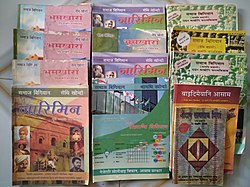Boro language (India)
Bodo (बर') or Boro is a Sino-Tibetan language spoken primarily by the Bodo people of Northeast India. It is official language of the Bodoland autonomous region and co-official language of the state of Assam in India.[1] It is also one of twenty two languages listed in the Eighth Schedule of the Constitution of India.[2] The Bodo language has been written using Devanagari script since 1963. Some scholar believe that at ancient time boro language were written in Deodhai script which is now lost.
| Bodo | |
|---|---|
| Boro Mech बर' | |
| Native to | Northeast India |
| Ethnicity | Bodo, Kachari, Mech |
| Native speakers | 1.48 million (2011 census)e18 |
| Language family | |
| Writing system | Devanagari (official) Bengali-Assamese (contemporary) Latin (Contemporary) Deodhai script (historically) |
| Official status | |
| Official language in | |
| Language codes | |
| ISO 639-3 | brx |
| Part of a series on | |
|---|---|
|
| |
| Constitutionally recognised languages of India | |
| Category | |
| Scheduled Languages | |
|
A
| |
| Related | |
|
Official languages of India
|
| Boro language (India) test of Wikipedia at Wikimedia Incubator |
History and linguistic classification
Bodo is a Sino-Tibetan language of the Bodo group. It is closely related to the Dimasa language and Tiwa (Lalung) Language of Assam. It is also related to the Garo language of Meghalaya and the Kokborok language of Tripura. The Bodo speaking areas of Assam stretch from Dhubri in the west to Sadiya in the east. In Alipurduar, Cooch Behar and Jalpaiguri and other parts of Bengal, the Boros are known as "Mech". According to the 1991 census, the population of Boro speakers was 1,984,569 (Bodo 1,324,748), (Mech 659,821). The census reports of Bodo tribe, however, includes only the Bodos. It excludes the Mech tribe. The word "Boro" means the language and the community. It is pronounced with a high tone on the second syllable.
Dialects
The dialects spoken in this area can be divided into three main groups:
- The Western Boro dialect, {(Sønabari) WBD}:
- The Eastern Boro dialect, {(Sanzari) EBD} and
- The Southern Boro dialect, {(Hazari) SBD}.
The Western Boro dialects are spoken in the districts of Kokrajhar and Bongaigaon. The Eastern Bodo dialects are found mainly in the districts of Barpeta, Nalbari and Kamrup and some parts of Darrang. The Western Boro dialect has gained the status of a standard dialect. It has also developed a written form. The variations between these two dialect groups are mainly phonological and lexical.
The Bodo language of Assam has at least four clear-cut dialect-areas with a sufficient number of dialectal variations. There are the northeastern, southwestern, north-central and southern dialect areas. Each has distinct differences.
Geographic distribution
Ethnologue lists the following districts where Bodo is spoken. Bodo is spoken mainly in the lowlands and foothills of Assam and West Bengal.
- Assam
- West Bengal
- Manipur
- Meghalaya
- 7 villages in Tikrikilla block of West Garo Hills district
- East Khasi Hills district
History
Although the Bodo language is a rich and ancient language, it did not have any written literature until the second decade of the 20th century. Christian missionaries, who entered the Bodo speaking areas to preach their religion, published some books on religion, tales, rhymes and songs. These missionaries also published some books on grammar and dictionary. Reverend Sidney Endle compiled An Outline of the Kachari Grammar in 1884. The grammar is based on the dialect of Darrang district. Endle also wrote an important book on the Bodos. It is titled The Kacharis. The book was published in 1911 and it contains chapters on social customs, agriculture practices, festivities, food habits, rituals, crafts and textiles of the Bodos. The book also included examples of Bodo folktales, rhymes and grammars. J.D. Anderson's Collection of Bodo Folktales and Rhymes (1895) included seventeen Bodo folktales translated into the English language. This is in addition to the original versions in the Bodo language.
In 1963 the language was used in teaching in the primary schools in Bodo dominated areas. The Bodo language is used in schools up to the secondary level. The language has become a matter of pride with the opening of the post-graduate course in the Bodo language. Bodo literature has been used in the University of Guwahati since 1996. The Bodo language now has a large number of books of poetry, drama, short stories, novels, biography, travel, children's literature and literary criticism. Though the spoken language has been affected by other communities and dialects, it is still to be heard in its pure form in and around the Udalguri district.
Writing system
The language is officially written using the Devanagari script. It also has a long history of using the Latin script and the Assamese script.[3] Some researchers have suggested that at one time the language used a now-lost script called Deodhai.[4]
Boro Language (India) Media
Related pages
References
- ↑ "THE ASSAM OFFICIAL LANGUAGE (AMENDMENT) ACT, 2020" (PDF).[dead link]
- ↑ "Languages Included in the Eighth Schedule of the Indian Constitution".
- ↑ Prabhakara, M S Scripting a solution Archived 2007-07-10 at the Wayback Machine, The Hindu, 19 May 2005.
- ↑ Battle of the Bodo language. MeriNews. 12 December 2007. http://www.merinews.com/article/battle-of-the-bodo-language/128494.shtml. Retrieved 9 April 2012.
Other websites
| Boro language (India) test of Wikipedia at Wikimedia Incubator |
- Abley, Mark (2006) The Verbs of Boro Archived 2020-12-22 at the Wayback Machine, Lost Magazine Archived 2021-01-26 at the Wayback Machine, March 2006
- Bodoland.org Archived 2010-11-24 at the Wayback Machine
- Boro Language
- Bodo computing resources at TDIL Archived 2010-08-03 at the Wayback Machine
- Language Information Service – India Archived 2011-04-09 at the Wayback Machine

